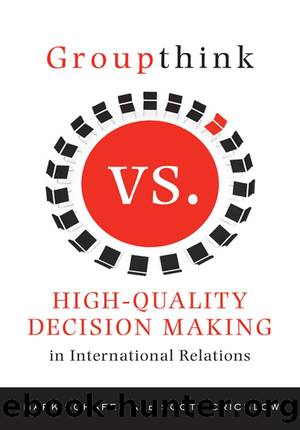Groupthink Versus High-Quality Decision Making in International Relations by Mark Schafer & Scott Crichlow

Author:Mark Schafer & Scott Crichlow [Schafer, Mark & Crichlow, Scott]
Language: eng
Format: epub
ISBN: 9780231148894
Goodreads: 8094744
Publisher: Columbia University Press
Published: 2010-04-22T00:00:00+00:00
PART III
Statistical Analyses
Six
THE EFFECT OF GROUPTHINK VERSUS HIGH-QUALITY DECISION MAKING ON OUTCOMES
Overview
In the previous two chapters, we have discussed a set of cases that demonstrate general support for our hypothesis: in those cases where poor structures and decision-making processes were used, the outcomes were quite poor; where better structures and processes were in place, the outcomes tended to be much more positive. Case studies are helpful for getting inside the decision process and seeing better and worse decision making at work in real episodes. Each case is a unique story, and it is important to look carefully inside the process of each. However, there are limitations to relying only on individual case studies to investigate our hypothesis. Our main interest is to better understand general patterns in decision making rather than the particulars of any one case. Put somewhat differently, an in-depth case study can tell us much about a particular case but relatively little about general patterns across a broad set of historical cases or about expected patterns in future cases.
Let us make this argument even more strongly and while doing so point out an important limitation of our own work thus far in the book. The cases we presented in the two previous chapters were not ârandomlyâ chosen. We selected cases based upon two general criteria: (1) they were important historical cases that included typical components of foreign-policy decisions, such as security challenges or ally relationships and (2) they exemplified the general pattern of the relationship between process and outcome that we have found in our research. In social-science terminology, that makes these cases a âpurposive sampleâ: they were chosen for specific purposes rather than randomly. This also means that we cannot assume they are representative of a larger sample of cases, and we are limited in drawing generalizable conclusions from them. This does not mean that they are not instructive. On the contrary, as noted above, getting inside a case is always instructive, especially a case that helps exemplify certain dimensions of decision making. But if we want to know whether the patterns in these cases are generalizable to a larger universe of cases, then we need a different type of analysis.
Statistical analysis allows us to look for such patterns. By comparing the same kind of informationâtranslated into dataâacross many cases, we can assess the probability that one or more variables affect the process or outcome of a case. So far our case studies have suggested that the quality of decision making is related to the quality of the outcome. Here we more systematically analyze that proposition (and others) by using data and statistics involving a much larger number of cases. Another result of statistical analysis can be the discovery of patterns that are not seen in an analysis of a handful of cases. This can increase the confidence in our findings.
In order to conduct statistical analysis, we need data. And in the present project, this means converting the information we gathered from all of our case studies into numerical representations.
Download
This site does not store any files on its server. We only index and link to content provided by other sites. Please contact the content providers to delete copyright contents if any and email us, we'll remove relevant links or contents immediately.
Zero to IPO: Over $1 Trillion of Actionable Advice from the World's Most Successful Entrepreneurs by Frederic Kerrest(4069)
Machine Learning at Scale with H2O by Gregory Keys | David Whiting(3645)
Harry Potter and the Goblet Of Fire by J.K. Rowling(3612)
Never by Ken Follett(3535)
Ogilvy on Advertising by David Ogilvy(3345)
Shadow of Night by Deborah Harkness(3178)
The Man Who Died Twice by Richard Osman(2811)
Book of Life by Deborah Harkness(2723)
My Brilliant Friend by Elena Ferrante(2705)
How Proust Can Change Your Life by Alain De Botton(2617)
0041152001443424520 .pdf by Unknown(2603)
Will by Will Smith(2581)
The Tipping Point by Malcolm Gladwell(2563)
How to Pay Zero Taxes, 2018 by Jeff A. Schnepper(2503)
Purple Hibiscus by Chimamanda Ngozi Adichie(2494)
Hooked: A Dark, Contemporary Romance (Never After Series) by Emily McIntire(2424)
Rationality by Steven Pinker(2151)
Borders by unknow(2119)
Daughter of Smoke and Bone by Laini Taylor(2083)
